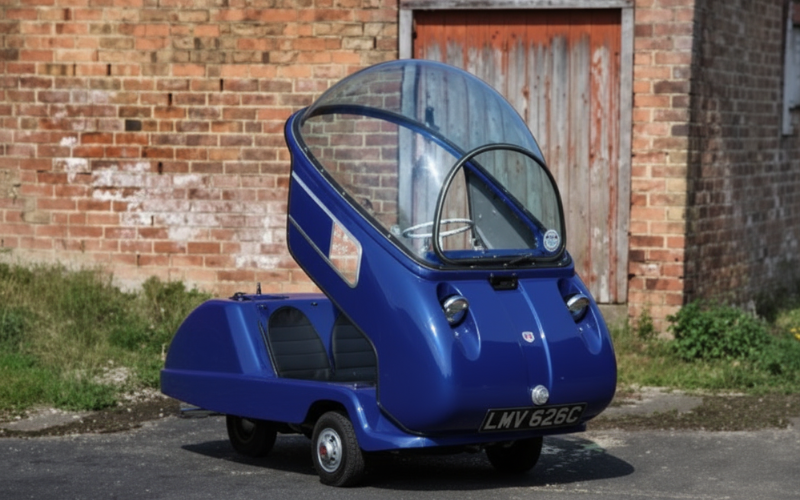Introduction
The Peel Trident is one of the smallest and most unusual cars ever built. First produced in the 1960s by the Peel Engineering Company on the Isle of Man, it quickly stood out for its futuristic bubble-shaped canopy and compact design. While it was never intended to compete with conventional cars, the Trident became a symbol of quirky innovation, showing just how far engineers were willing to push the idea of personal transport. Today, it remains a rare collectible that fascinates car enthusiasts and casual admirers alike.
The Origins of the Peel Trident
Background on Peel Engineering Company
The Peel Engineering Company was a small firm based on the Isle of Man, originally known for producing fiberglass boats and motorcycle fairings. In the early 1960s, they decided to experiment with ultra-compact personal transport. Their focus was on creating lightweight, economical vehicles that could be built simply and sold affordably. This ambition led them into the world of microcars, a niche but fascinating corner of automotive history.
How the Trident Followed the Peel P50
Before the Trident came the Peel P50, a tiny three-wheeled car that holds the Guinness World Record as the smallest production automobile ever made. While the P50 proved that extreme downsizing was possible, Peel wanted to build something slightly more practical and appealing to everyday drivers. The Trident was introduced in 1965 as their answer — it had room for two people, a futuristic bubble canopy, and a more playful look compared to the minimalist P50.
Distinctive Design Features
Bubble Canopy and Futuristic Styling
One of the most striking aspects of the Peel Trident was its clear, dome-shaped canopy. Made from plexiglass, it gave the car a space-age look that felt more like a mini spaceship than a road vehicle. This design wasn’t just about looks — the canopy allowed for excellent visibility and gave the small cabin an airy feel, even though space inside was very limited. In the 1960s, when futuristic styling was gaining attention in many industries, the Trident’s design captured the spirit of the era perfectly.
Ultra-Compact Size and Layout
Despite being slightly larger than the Peel P50, the Trident was still remarkably tiny. It measured just over six feet in length and weighed around 150 kilograms, making it light enough to be moved by hand. Inside, the layout was extremely simple: two seats placed side by side, basic controls, and almost no storage space. Its three-wheel configuration kept production costs low and reinforced its identity as a microcar rather than a conventional automobile.
Performance and Practicality
Engine Specifications and Driving Experience
The Peel Trident was powered by a small 49cc two-stroke engine, the same type often found in mopeds of the time. With just a few horsepower, its top speed reached around 28 mph (45 km/h). While modest, this was more than enough for short city trips or village roads. Driving the Trident was a quirky experience — its lightweight frame, tiny wheels, and narrow track made it feel very different from a standard car, often more like riding a scooter with a shell around it.
Everyday Usability and Limitations
In practical terms, the Trident was designed for very short journeys. It offered seating for two, but the cabin was cramped, and luggage space was almost nonexistent. The clear canopy, while stylish, could make the interior hot in sunny weather, and it offered little insulation against cold or rain. Its limited speed and size also made it unsuitable for highways. However, for urban environments where parking was scarce and distances short, the Trident’s ultra-compact design gave it a unique advantage.
Cultural Impact and Popularity
Appearances in Media and Pop Culture
Although only a small number of Peel Tridents were produced, their unusual design has kept them in the public eye. The car’s bubble-like shape and tiny size made it a novelty, often featured in documentaries, motoring shows, and exhibitions about unusual vehicles. Its futuristic look, which seemed playful rather than practical, gave it a place in pop culture as a symbol of quirky mid-20th-century design. For many people, the Trident is remembered less as a mode of transport and more as a conversation piece that pushed the boundaries of what a “car” could be.
Collector Interest Over the Years
Because of its rarity, the Peel Trident has become a sought-after collector’s item. Surviving original models are extremely scarce, and when they appear at auctions, they often attract significant attention. Enthusiasts value the car not just for its odd design but also for its historical importance as part of the microcar movement of the 1960s. Replicas and recreations have also grown in popularity, allowing fans to experience the Trident’s charm without the challenges of owning an original.
The Peel Trident Today
Surviving Models and Rarity
Original Peel Tridents are incredibly rare, with only a handful believed to survive from the small production run in the mid-1960s. Because many were used as novelty cars rather than everyday vehicles, few were preserved in good condition. Those that remain are usually found in private collections or on display in museums dedicated to unusual or historic cars. Their scarcity makes them highly valuable, often selling at premium prices when they appear at classic car auctions.
Replica Versions and Modern Recreations
The charm of the Trident has inspired modern recreations and replica models. Some small companies and enthusiasts have built faithful reproductions, often using updated materials and engines to make them more reliable for modern use. These recreations allow new generations to experience the fun of the Trident without relying on fragile originals. While purists may value the historical authenticity of surviving cars, replicas have helped keep the quirky spirit of the Peel Trident alive in today’s automotive culture.
Conclusion
The Peel Trident may never have been a practical everyday car, but it captured imaginations in a way few vehicles ever have. With its bubble canopy, three-wheel layout, and playful design, it stood out as a bold experiment in personal transport during the 1960s. Today, its rarity and unique character make it a prized collector’s piece, while modern replicas keep its spirit alive for new audiences. More than just a microcar, the Peel Trident represents a moment in automotive history when creativity and curiosity were valued as much as speed or practicality.
FAQ
Q1: What makes the Peel Trident different from the Peel P50?
The Peel Trident was designed as a two-seater with a bubble canopy, whereas the P50 was a single-seater with a much simpler design. The Trident offered slightly more space and a more futuristic look compared to its record-holding sibling.
Q2: How many Peel Tridents were originally built?
It’s estimated that fewer than 100 Peel Tridents were produced between 1965 and 1966. Only a small number survive today, which makes them rare collector’s items.
Q3: Can you legally drive a Peel Trident today?
Yes, the Peel Trident can be legally driven on public roads in some regions, provided it is registered and insured like other vehicles. However, due to its limited speed and safety features, it is best suited for short trips or display use.
Q4: Why is the Peel Trident considered a collector’s item?
Its rarity, unique design, and place in automotive history make the Trident highly desirable among collectors. Few original examples remain, and their unusual style ensures lasting interest from enthusiasts.

